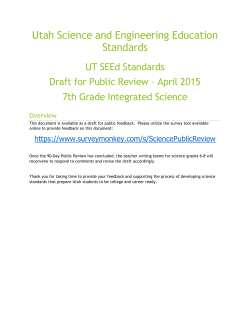
Genetic risk assessment for sampling and use of native seed: the
Genetic risk assessment for sampling and use of native seed: the example of the UK Native Seed Hub Michael Way*, Kate Hardwick, Ted Chapman, Inna Birchenko, Linda Neaves m.way@kew.org Context: Millennium Seed Bank Partnership: world flora Over 100 partners in 50 countries Context: Millennium Seed Bank Partnership world flora Sampling strategy Purpose Focus Sampling & use To combat potentially catastrophic threats to human wellbeing by • safeguarding wild plant diversity and • enabling its sustainable use by global partnership. Global plant diversity, especially threatened and endemic species Minimum of one large bulked population sample per target species. Samples of 50 seeds provided for biological research & education use. My talk • The UK Native Seed Hub • Genetic Risk Assessment • Worked examples 1. Primula veris 2. Hippocrepis comosa • Conclusions • Acknowledgements UK Native Seed Hub: -UK habitat loss Species Rich Grassland 97% loss 1930-1984 (Lawton et al., 2010) Ancient Woodland 45% loss 1930-1985 Lowland Heath 80% loss 1800-1980 UK Native Seed Hub: -The habitat restoration challenge “To make space for nature we need more, bigger, better and joined up sites to create a sustainable, resilient and more effective ecological network for England.” (Lawton et al., 2010) UK Native Seed Hub: Maintaining representative genetic diversity: Collect representative population samples Maintain diversity by using robust protocols throughout storage/multiplication Provide guidance on use of material UK Native Seed Hub Sampling strategy Purpose Focus Sampling & use To supply source-identified and quality-tested seed that will contribute to selfsustaining plant communities in restored habitats. Annual and herbaceous perennial flowering plants in demand for grassland creation and restoration. How many populations and from where? Can material be translocated within its native range? Genetic Risk Assessment Genetic Risks to consider Proposed action Risk to consider DO NOTHING: Risk of Inbreeding depression & genetic drift SAMPLING: Risk that several population samples chosen at random across native range will NOT adequately represent genetic diversity of the species. Risk of harvesting beyond a safe level CONSERVATION TRANSLOCATION: Risk of Hybridisation, Outbreeding Depression or Genetic Swamping Genetic Risk Assessment Previous large scale risk assessment study The risk of disruption to existing populations of 151 UK native species was assessed based on: (1) Dispersal ability (2) Breeding system 1. 2. 3. the scale of introduction, in terms of the overall supply and use of seed life-history traits known to determine the partitioning genetic diversity the degree of intraspecific variation Walker, K.J., Hodder, K.H., Bullock, J.B., Pywell, R.F. 2004. A review of the potential effects of seed sowing for habitat re-creation on the conservation of intraspecific biodiversity. (3) Phenology (4) Reproduction (5) Pollen vector (6) Life history (generation time) (7) Seed weight (8) Habitat breadth Genetic Risk Assessment Framework for estimating Genetic Risk Genetic risk Categories Initial species selection 60 Species are proposed for reintroduction and shortlisted based on: •Historic distribution •Conservation status •Available estimates of genetic risks •Seed availability and quality •Public involvement and interest Evidence gathering Literature review of species traits and genetic research including: 8 38 MODERATE RISK: • Genetic structure or highly divergent populations are detected 14 HIGH RISK: • Potential for loss of genetic diversity is detected molecular genetics common garden & phylogenetic studies Identify gaps in knowledge 29 priority for research LOW RISK: • The species is widespread and genetically uniform throughout the range • Not enough information Genetic Risk Assessment Implications of genetic risk categories Use of material Genetic risk category Minimum Sampling of material use anywhere within native range LOW stratified random sample from minimum number of populations use only within ‘seed zone’ MODERATE sample from populations representing ecological and genetic divisions use only at origin HIGH sample from all populations e.g. to capture divergent lineages and adaptations Worked examples: 1. Primula veris (cowslip) Evidence: •Insect pollinated •Obligate out-breeder •Thrum & pin flower morphs •average dispersal distance of pollen and seed is low •Widely included in grassland native seed mixes since 1980s Image: H Zell CC-BY-SA Worked examples: 1. Primula veris (cowslip) Evidence: • Widespread distribution UK & Europe • Genetic diversity of species is significant • Populations reduced in extent and size in UK • Genetic drift evident in some small populations Sampling & use: Low genetic risk Distribution of Primula veris at 10 km2 scale, accessed at data.nbn.org.uk, © Crown copyright and database rights 2011 Ordnance Survey [100017955] Worked examples: 2. Hippocrepis comosa (horse shoe vetch) •Insect pollinated •Obligate out-breeder •Limited seed dispersal • Fragmented distribution Cytotypes •Diploid form is an ancient relict, confined to inaccessible sites •Tetraploid more variable and widespread, prostrate Worked examples: 2. Hippocrepis comosa (horse shoe vetch) Uncertainty where the cytotypes are & likely negative consequences of mixing cytotypes: •Sampling: Moderate risk of missing some diversity, so sample from wide range of environments •Use: High risk of disrupting local genetic diversity, local use only Distribution of Hippocrepis comosa at 10 km2 scale (data.nbn.org.uk) accessed at data.nbn.org.uk, © Crown copyright and database rights 2011 Ordnance Survey [100017955] Conclusions • Species-by-species approach is required, and dedicated genetic studies are recommended • The low-moderate-high Genetic Risk system allows for better understanding and easier use in decision-making • Estimates of Genetic Risk can be made with partial evidence • Risk based approach can inform sampling and use strategy • Recommendation not prescription: it’s for the natural resource managers to make decisions Acknowledgements • UK National Tree Seed project: Clare Trivedi, Simon Kallow • UK Flora project: Stephanie Miles • Genetic Research and advice: Inna Birchenko, Linda Neaves, Mike Fay, and partner organisations • Esmée Fairbairn Foundation To find out more about the UK Native Seed Hub visit www.kew.org/seedhub or email seedhub@kew.org The preceding presentation was delivered at the 2015 National Native Seed Conference Santa Fe, New Mexico April 13-16, 2015 This and additional presentations available at http://nativeseed.info
© Copyright 2025









